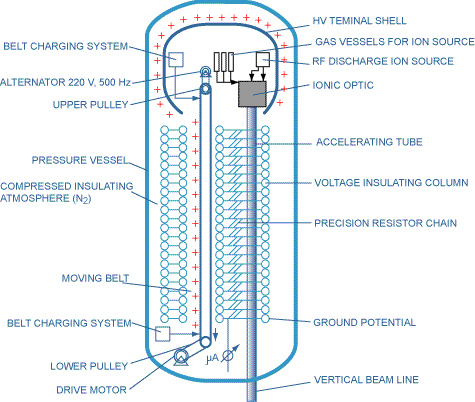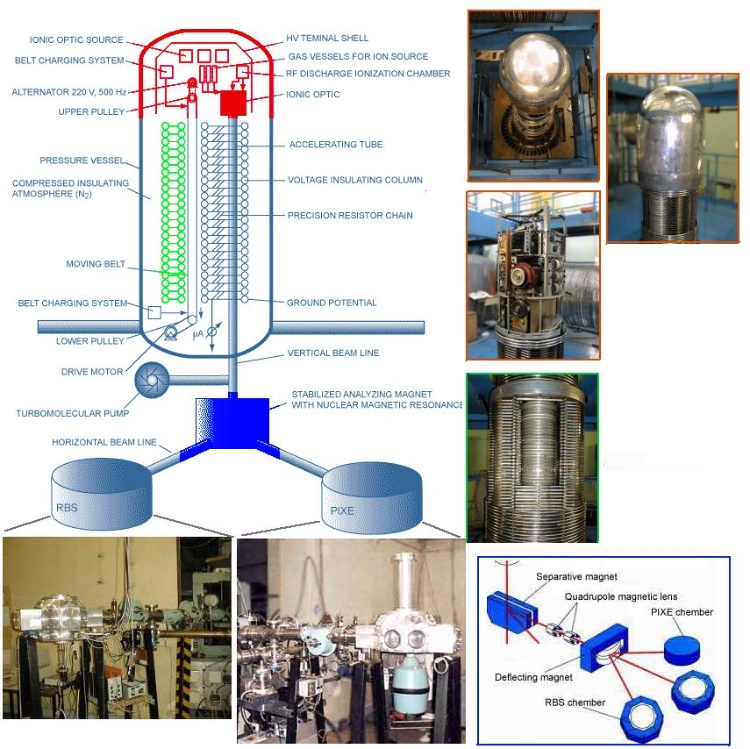
van de Graaffův urychlovač
Od počátku 60. let 20. století byly v ÚJF vyvíjeny a široce využívány metody jaderné analýzy. Šlo zejména o neutronovou aktivační analýzu a metody rychlé analýzy svazky nabitých částic i neutronovými svazky. Analytické metody byly dále vyvíjeny, byly získány zkušenosti s jejich praktickou aplikací a navázána spolupráce s mnoha českými i zahraničními vědeckými institucemi i společnostmi.
Tyto metody mají několik jedinečných charakteristik, které nelze nahradit jinými přístupy. V minulosti byl v ÚJF pro tyto účely využíván elektrostatický Van de Graaffův urychlovač, ke kterému byla postupně vyvinuta a připojena zařízení pro analytické metody, jako jsou PIXE, RBS, ERDA, PIGE či NRM. Skupina jaderných analytických metod, z níž vzniklo dnešní Oddělení neutronové fyziky, se systematicky podílela na studiu syntézy, struktury a vlastností pokročilých materiálů pro mikroelektronické, optické, optoelektronické i kryogenní materiály a další materiály s exkluzivními vlastnostmi (vysoká tvrdost, chemická odolnost, biokompatibilita atd.). Svazek urychlených iontů je využíván pro povrchovou modifikaci pevných látek a pro analýzu jejich složení a struktury. Povrchové struktury a systémy připravené ve spolupráci s českými a zahraničními ústavy různými metodami (epitaxiální růst, Czochralskyho metoda, iontová implantace, depozice plazmového polymeru, CVD, PCVD, magnetronové rozprašování atd.) jsou analyzovány zmíněnými a dalšími analytickými metodami, již vyřazený van de Graafův urychlovač byl přitom nahrazen zejména lineárním urychlovačem Tandetron, instalovaným v letech 2005-6.
The Van de Graaff machine was designed by an American physicist Robert Jemison Van de Graaff (1901-1967).
Here a continually moving belt of insulating material runs between two pulleys which are separated by an insulated column. The lower pulley is earthed and attached to. The pulley is a sharp metallic comb which is maintained at a potential difference of a few kV between itself and the pulley. A high electric field is produced at the time of the comb. The electrical discharge occurs through the belt from the comb to the pulley, removing electrons from the belt, making it positively charged. The belt carries the charge up to the top pulley which is inside a large ball shaped metal electrode. The electrode then gets an increasing positive charge with correspondingly high electric potential. The voltage rises rapidly until an equilibrium is established where the rate of loss of negative charge balances the positive charge currently carried by the moving belt. In this way, the Van de Graaff machine can reach very high electric potentials of a few million volts.
In a Van de Graaff accelerator, the high electric potential is coupled to an accelerating tube. At it's top there is an ion source that produces the particles to be accelerated. The maximum accelerating potential is limited by breakdown across the accelerating tube and charge leakage from the high voltage electrode. However, with careful design, Van de Graaff accelerators operating at accelerating potentials in excess of 25 MV have been built.

Pictures are bordered with colored border. Pictures corresponds to Van de Graaff part in scheme with same color.


